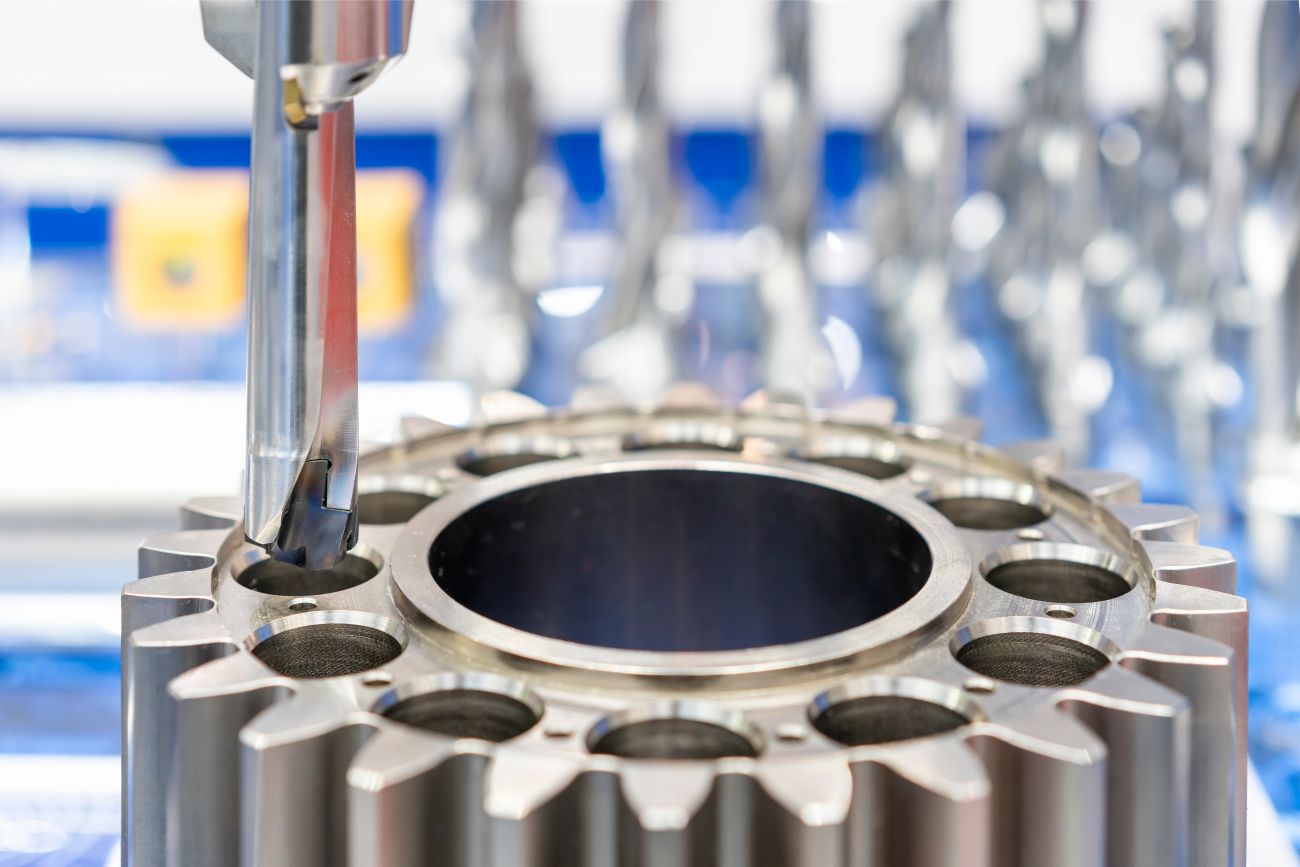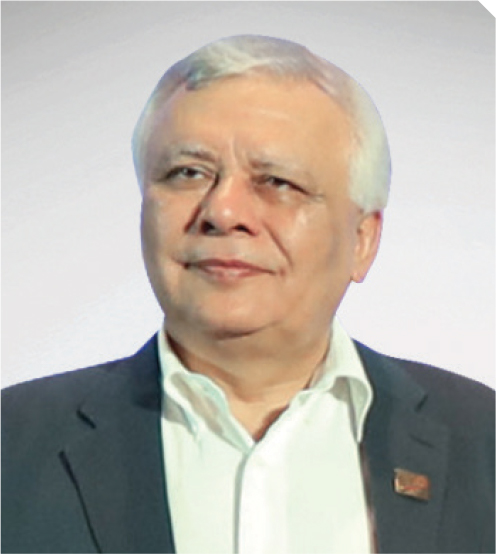CUTTING’-EDGE INSIGHTS

The Indian cutting tool industry is making significant strides forward owing to the country's economic growth and robust industrial production capabilities, particularly bolstered by sectors like automotive and aerospace. Industry leaders from the sector share their two cents on key factors, including the adoption of advanced technologies and exploring of carbide cutting tool trends, and suggest ways to get ahead of the curve.
In this fast-paced world, the only constant is change. The Cutting Tool industry is no different. As industries demand more precision and quality in their products, the demand for cutting tools has increased. The global metal cutting tool market was worth US$ 65.5 billion in 2020 and is projected to reach US$ 107.3 billion by 2032, expanding at a CAGR of 4.1 percent from 2023-2032, according to Allied Market Research.
Since, carbide cutting tools excel at precision machining, it is fast gaining prominence and is expected to continue to lead the pack of cutting and machining solutions, rising at a considerable rate during the forecast period, between 2024 and 2031, globally. The global carbide cutting tools market has risen steadily since 2023, and with the rising adoption of strategies by major players, the market is expected to rise over the projected horizon.
|
CERATIZIT India Pvt Ltd |
|
|
Popularity of high-efficiency CNC machines drives market growth
The growth of the metal cutting tools market is driven by the economic growth in developing countries like India. The Indian economy is experiencing rapid growth in the Manufacturing sector and increasing consumption among the population. Major industries like Aerospace, Automotive, Electronics, and Medical Devices are shifting their manufacturing base to India, which will give a big boost to our Manufacturing sector. Advancements in the metal cutting tools market are expected to drive market growth, such as tools with higher heat sustenance and greater precision. The increasing popularity of high-efficiency CNC machines is also a major factor in market growth. Industry 4.0 with cutting tools The convergence of Industry 4.0 with cutting tools is a megatrend imposing opportunities for trade and adoption in the cutting tools market. CERATIZIT is paving the way for the digital future of machining. |
A central element of this is the Tool Scope monitoring and control system, which continuously records signals from the machine that are generated during the production process. This data is visually displayed and used to monitor and adjust the machine. The major benefits of Tool Scope are process control, machine protection, documentation, and digitization.
Tungsten carbide driving growth
The global carbide cutting tools market is expected to grow at a CAGR of 5.2 percent from 2023 to 2028. The milling tools segment is expected to be the fastest-growing segment in the market in the near future, attributing high efficiency, rigidity, and hardness of the milling tools over the latter products. Due to its effectiveness, it is also utilized in the burgeoning Automotive and Construction industries. Hence, the market for milling tools is expected to be the largest. The Automotive segment is expected to be the fastest-growing segment in the global carbide cutting tools market, driven by the use of tungsten carbide in different components like ball joints, brakes, and crankshafts.
Furthermore, with the rising demand for e-vehicles and increasing manufacturing capacity, the growth of this market is foreseen, while the increasing use of coated tools in the Aerospace, Automotive, and other industries is expected to promote the segment’s expansion.
|
GPAINNOVA |
|
Skill development also supports Indian cutting tools market There are several key factors driving the growth of the cutting tools market in India. The rapid expansion of the Manufacturing sector, especially in Automotive, Aerospace, and Industrial Machinery, is a significant driver. Government initiatives like ‘Make in India’ promote domestic production and infrastructure development, boosting demand for cutting tools. Advancements in technology, such as the adoption of CNC machines and automation, enhance precision and efficiency, increasing the need for high-quality cutting tools. Additionally, the rise of small and medium-sized enterprises (SMEs) and increased foreign direct investment (FDI) contribute to market growth. The emphasis on skill development and training in advanced manufacturing techniques also supports the expanding cutting tools market in India. |
|
Advanced technologies collectively drive innovation
Technologies like additive manufacturing, digital twin, and Industry 4.0 significantly enhance cutting tool manufacturers’ product performance and development. Additive manufacturing (AM) enables the production of complex, custom-designed tools with improved efficiency and material utilization. Digital twin technology allows for precise simulation and optimization of tool designs, predicting performance and reducing development time. Industry 4.0 integration facilitates real-time data analytics, predictive maintenance, and automation, leading to higher quality, consistent output, and reduced downtime. These technologies collectively drive innovation, improve product reliability, and enhance competitiveness in the market, ensuring manufacturers can meet the evolving demands of advanced manufacturing sectors.
Precision manufacturing and CNC machines need high-quality carbide tools
It is worth it to highlight the increasing demand for high-performance and durable tools driven by the Automotive, Aerospace, and Industrial Machinery sectors. Advancements in coating technologies, such as PVD and CVD coatings, enhance tool lifespan and cutting efficiency. The shift towards precision manufacturing and the use of CNC machines necessitates high-quality carbide tools. Additionally, the integration of smart technologies and Internet-of-the-Things (IoT) for real-time monitoring and predictive maintenance is becoming prevalent. Sustainability trends are leading to the development of eco-friendly carbide tools with reduced environmental impact. The market is also witnessing growth due to the rise in automated manufacturing processes and the expansion of the Renewable Energy sector, which demands specialized cutting tools.

|
Guhring India Pvt Ltd |
|
|
Growth factors
India’s industrial sector is experiencing significant growth, particularly in sectors like Automotive, Aerospace, Defence, Medical Implants & Devices, and Electronics, which require high-precision machining, leading to an increased demand for advanced cutting tools capable of delivering precision and productivity. In addition to the ‘Make in India’ initiative, encouraging domestic manufacturing and boosting foreign investments in the Manufacturing sector, export-oriented industries, such as components’ manufacturing, rely heavily on cutting tools for manufacturing processes. Enhancing efficiency Additive manufacturing enables the production of complex geometries and customized tool designs that are difficult to achieve with traditional manufacturing methods, using advanced materials with high strength, wear resistance, and thermal conductivity. Digital twins enable cutting tool manufacturers to analyze and optimize tool performance parameters, such as cutting forces, chip formation, and surface finish. |
Industry 4.0 enables autonomous tool storage and machining systems where cutting tools interact with machines and robots, streamlining workflows, reducing human intervention, and enhancing manufacturing efficiency.
Global trends in carbide cutting tools
High-speed machining and high-performance cutting techniques are driving the demand for cutting tools capable of withstanding high cutting speeds and feeds while maintaining dimensional accuracy and surface finish. Advanced grades, tool geometries, chip management, and coatings are key enablers to achieve higher productivity and efficiency in machining operations. Industries are increasingly seeking customized cutting tools, promoting manufacturers to offer a wide range of specialized tool geometries, grades, and coatings to meet the diverse needs of end-users. Sustainability is also influencing the development of cutting tools for eco-friendly technologies like Minimum Quantity Lubrication (MQL), recycling carbide scrap, and sustainable material sourcing.
|
G.U.S.T.I., Global Unified Source for Technology Integration Pvt Ltd |
|
India: The new manufacturing hotspot The global focus is shifting to India for manufacturing. The factors collectively contributing to the growth of the cutting tools market in India, with opportunities for both domestic manufacturers and international players, are industrial expansion, technological advancements, Government initiatives like ‘Make in India’, the rising Automotive and Electronics sectors, increasing machining requirements, the growing construction sector, a focus on productivity and efficiency, rising disposable income, and globalization. Leveraging technology We have incorporated Industry 4.0 and Digital Twin technology since inception and are also in the process of using 3D-printed bodies for some applications. By leveraging these technologies, cutting tool manufacturers can enhance product performance, increase efficiency, reduce costs, and maintain a competitive edge in the market. |
TOSHER G HORMUSJEE |
Additionally, these technologies facilitate the transition towards smart factories and digitized manufacturing ecosystems, enabling greater agility, flexibility, and responsiveness to customer needs. Productivity enhancement is a key factor in the selection of cutting tools.
Focus on material science and sustainability
Several global trends are shaping the carbide cutting tools market, including advancements in material science for improved wear resistance and increased productivity, demand for high-performance tools for machining challenging materials like titanium alloys, hardened steels, and high-temperature alloys, a focus on sustainability, digitalization and Industry 4.0 integration, customization and personalization, the rise of additive manufacturing, a shift toward electric vehicles (EVs), and global supply chain dynamics. Understanding this trend, we use only the best-in-class material manufactured in Germany and Switzerland.
|
Ind-Sphinx Precision Ltd |
|
SUNIL TANEJA |
New sectors driving growth Geo-politics and Geo-Economics are driving the growth of the Indian Machining sector. As India takes its due place as a manufacturing superpower, machining is on an uptrend. New sectors like Electronics, 3C (Computers, Communications, and Consumer Electronics), Medical, Aerospace, etc. are driving the demand. Another growth catalyst is auto-component exports. Cutting-edge tech takes center stage Technologies like Additive Manufacturing, Digital Twin, and Industry 4.0 are important for cutting tool manufacturing, and the Indian Cutting Tool industry is also adopting these new technologies. Indian cutting tool makers are very progressive, and they are sure to benefit from these technologies in order to stay competitive. |
Precision reigns supreme
The global trends in carbide cutting tools are very clear: precise tools, high-precision coatings, emerging materials, and demanding customers. We are very optimistic about high-precision manufacturing in India, which will drive cutting tool demand in India.
|
TaeguTec India Pvt Ltd |
|
Government initiatives support growth India’s Manufacturing sector is expanding rapidly, particularly Automotive and Aerospace, where cutting tools are indispensable, showcasing a manufacturing boom. The increasing need for high-quality, precise components across industries also drives the demand for advanced cutting tools that offer accuracy and efficiency. Government support such as ‘Make in India’ and similar initiatives prioritizes domestic manufacturing, boosting the demand for locally produced cutting tools, and the growth in infrastructure projects that require substantial construction machinery usage creates a larger market for durable cutting tools. 3D printing, digital twin, and Industry 4.0 Additive manufacturing/3D printing allows for complex tool designs with optimized geometries for specific applications, improving cutting performance while reducing material waste. |
L KRISHNAN |
Digital Twin creates virtual simulations of cutting tools to predict performance, identify wear areas, and optimize designs, facilitating faster and more cost-effective product development. Lastly, Industry 4.0 offers data-driven insights from connected machines, allowing for real-time monitoring, preventative maintenance, and reduced downtime, improving tool lifespan and productivity.
Emphasizing eco-friendly cutting processes
Advanced coatings that enhance wear resistance, heat tolerance, and surface finish are becoming increasingly specialized, allowing higher cutting speeds and longer tool life. The need for precision machining in electronics and medical devices also fuels the demand for extremely small (miniaturization), high-performance carbide cutting tools.
Sustainability—another key trend—focuses on eco-friendly cutting processes, driving research into tool designs, reducing energy consumption, and supporting recycling, in addition to hybrid tools, i.e., combining carbide with other cutting materials for applications where specific properties (like diamond hardness) can enhance performance.
|
Vollmer Technologies India Pvt Ltd |
|
RAVINDRA SD |
The 3C ripple effect The demand for global carbide cutting tools is likely to go up due to the current investments happening in the 3C sectors globally. This would also, in a way, influence the demand for cutting tools in India as well. However, Vollmer being the Capital Goods industry and being in the secondary part of the supply chain, we may see increased demand for grinding machines as well. The cutting tool producers will first experience this demand-supply gap going forward. However, in geopolitical situations, interest rate cuts are also going to have a say in this demand-supply situation. Cutting tool market charts consistent growth course The market is going to rise due to the demand for the 3C products. The demand will go up also for the cutting tools,owing to this reason. We are seeing the increased demand for tools and many customers are requesting new technology machines to invest in. In my opinion, the market is going to be on a steady pace in 2024-25 and will continue to grow steadily going forward. |
|
GIST AT A GLANCE |
Key Growth Drivers
- Rapid expansion of Manufacturing sectors like Automotive, Aerospace, and Industrial Machinery
- Government initiatives like 'Make in India' promoting domestic production
- Adoption of advanced technologies like CNC machines and automation
- Rise of SMEs and increased FDI in manufacturing
- Emphasis on skill development and training in advanced manufacturing techniques
Cutting Tool Materials in Demand
- Tungsten Carbide Tools (Strength, Wear Resistance, High Temperatures)
- Diamond Coated Tools (Hardness, Low Friction)
- Ceramics (Heat Resistance, Hardness)
- Cubic Boron Nitride (CBN) (Hardness, Thermal Conductivity)
Emerging Technology Trends
- Additive Manufacturing for Custom Tool Designs
- Digital Twins for Virtual Simulation and Optimization
- Industry 4.0 Integration (IIoT, Data Analytics, Predictive Maintenance)
- Advanced Coatings (PVD, CVD) for Longer Tool Life
- Miniaturization for Electronics and Medical Devices
Sustainability Focus
- Eco-friendly Cutting Processes
- Tool Designs for Reduced Energy Consumption
- Support for Recycling and Material Reutilization
- Minimum Quantity Lubrication (MQL) Techniques
- Sustainable Material Sourcing
 |
Poonam Pednekar
|
 |
SOVAN TUDU
|




 ANIL KUMAR
ANIL KUMAR






 Facebook
Facebook.png) Twitter
Twitter Linkedin
Linkedin Subscribe
Subscribe